FYBUSH.COM/SITE OF THE WEEK
NEEDS YOUR SUPPORT! (AND YOU CAN GET A FREE TOWER SITE CALENDAR
IF YOU PLEDGE NOW...) CLICK HERE TO
LEARN MORE...
June 12-26, 2003
Asheville and Western North Carolina
In last week's recap of our March visit to the Carolinas,
we found ourselves crossing the South Carolina-North Carolina
border on US 25, heading for a rendezvous with one of our favorite
radio stations anywhere.
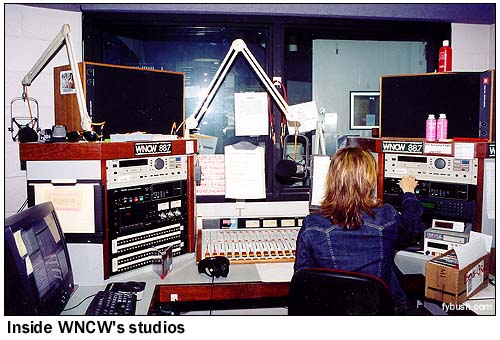 If you're a fan
- as we are - of AAA and Americana music, you just might have
heard of WNCW (88.7) in Spindale, North Carolina. In just a decade
and a half on the air, the radio station of Isothermal Community
College has become one of the flagships of the genre, blanketing
western North Carolina and portions of four adjacent states with
a nonstop AAA format from a transmitter adjacent to the highest
point in the East (don't worry - we'll get there) and several
translators. If you're a fan
- as we are - of AAA and Americana music, you just might have
heard of WNCW (88.7) in Spindale, North Carolina. In just a decade
and a half on the air, the radio station of Isothermal Community
College has become one of the flagships of the genre, blanketing
western North Carolina and portions of four adjacent states with
a nonstop AAA format from a transmitter adjacent to the highest
point in the East (don't worry - we'll get there) and several
translators.
We've long admired WNCW from afar, thanks to its Webcast,
the occasional traded aircheck and loving mentions of the station
in albums by artists like Asheville native David Wilcox - so
it was a thrill to stop by for a visit, made doubly so when it
turned out that several of the staffers were loyal NorthEast
Radio Watch readers!
Alas, WNCW is having a rough go of it. First, the station
was singled out by the FCC a couple of years ago for an investigation
of underwriting announcements that promoted a concert WNCW was
sponsoring (with a commercial promoter). That led to an FCC admonishment,
which included some rather fanciful logic about what would have
happened if WNCW had been using that event to try
to boost membership. The whole thing seemed rather flimsy to
us (especially considering some of the out-and-out commercials
we've heard on less responsible noncomms), but it was one strike
against the station nonetheless. Then came the realization
that WNCW's translator in Charlotte (W264AF on 100.7), some 90
miles away, was threatened by Susquehanna's proposed move-in
of WABZ (100.9 Albemarle NC) to suburban Indian Trail. A listeners'
group in Charlotte (savewncw.org)
was formed to try to oppose the move-in, but of course translators
are a secondary service, and the likelihood of saving WNCW's
service to Charlotte seems dim at best. (The Web site hasn't
been updated in months...)
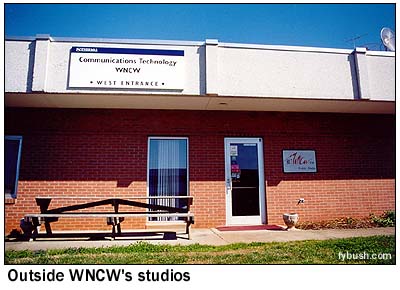 And then, as we were
doing some research for this week's column, we found that "Save
WNCW" has been joined by "Preserve WNCW" (preservewncw.org), a
new listeners' group that's trying to make sure WNCW doesn't
disappear completely. And then, as we were
doing some research for this week's column, we found that "Save
WNCW" has been joined by "Preserve WNCW" (preservewncw.org), a
new listeners' group that's trying to make sure WNCW doesn't
disappear completely.
It seems that the trustees of Isothermal Community College
may not fully appreciate the value of their radio station; between
the "WNCW Case" at the FCC and some unfortunate staffing
issues, the college appears to think that running a radio station
may be taking up too much of its time - and just may be contemplating
selling WNCW.
Who buys noncommercial licenses - especially ones that cover
huge chunks of a state? Hint: they usually don't program AAA
music on them. And as you'll see in a bit, it's not as though
there's any shortage of religion on the dial in WNCW's
coverage area.
In any case, this is one nice facility: you can see the air
studio above, and just down the hallway (in a space originally
meant to be a TV studio, next to a room that's used as a Rutherford
County bureau for Asheville's WLOS-TV) is a huge room for live
performances and recording. (WNCW also does a lot of ISDN remotes
from Asheville, an hour or so away, for artists who are traveling
through the area but don't have the time to make the shlep to
Spindale.)
So we're certainly glad we saw WNCW when we did, and we hope
the Isothermal folks wake up to the value of their asset. (Data
point: while Garrett Wollman and your editor are hardly your
traditional tourists, the fact remains that we made western North
Carolina a destination on this trip, spending money on hotels
and meals, in part because of the image of the region
WNCW has given us over the years.)
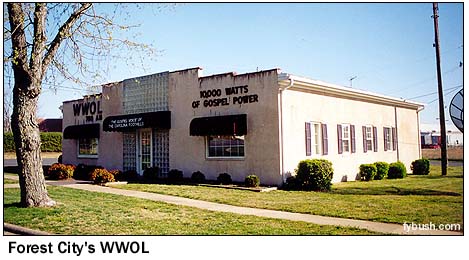 WNCW isn't the only
radio station in town, of course; in fact, there are four AMs
in "Greater Spindale." WNCW isn't the only
radio station in town, of course; in fact, there are four AMs
in "Greater Spindale."
WWOL (780) in Forest City has the biggest signal, 10 daytime
kilowatts from a single tower next to that pretty building. WCAB
(590) in Rutherfordton does talk and country; WAGY (1320) in
Forest City plays classic country, and WGMA (1520) in Spindale
is black gospel. (We missed getting a WGMA legal, for some reason...)
Like all the AMs in this rocky region, they're all fairly
small-coverage signals.
(WTPT 93.3 is licensed to Forest City as well, but it's a
big C that serves the greater Spartanburg/Asheville/Greenville
market.)
From the Spindale area, we head back toward Asheville, taking
advantage of the recently-upgraded US 64 expressway to get us
back to Tryon City (home of 1160 WJFJ) and into Hendersonville,
home to WTZQ (1600), which simulcasts Asheville's WISE (1310),
and a nice local station, WHKP (1450).
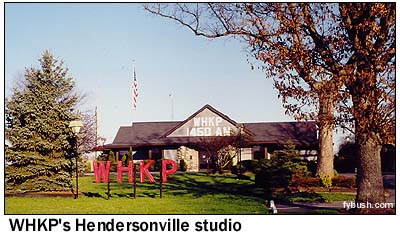 WHKP has a very pretty
building just east of downtown Hendersonville, a pleasant-looking
little town indeed. WHKP has a very pretty
building just east of downtown Hendersonville, a pleasant-looking
little town indeed.
(Later that night, we'd find out that a fellow member of the
National Radio Club lives in Hendersonville and might have arranged
a tour of WHKP if only we'd known in time; another reason to
go back, I suppose...)
From Hendersonville we catch I-26 north (well, west) toward
Asheville, hopping off a few exits early amidst surprisingly
heavy late-afternoon traffic to see the new studios of ABC affiliate
WLOS (Channel 13), which we locate in a business park just off
the interstate.
WLOS, as we mentioned last week, is the only "big three"
affiliate in the Asheville/Greenville/Spartanburg market that's
located in North Carolina, and its newscasts tend to focus very
heavily on that side of the market, a division the ratings reflect.
(Fox affiliate WHNS is licensed to Asheville but operates from
studios near Greenville, S.C.; UPN affiliate WASV, also licensed
to Asheville, is operated by WSPA-TV in Spartanburg.) WLOS also
operates WB affiliate WBSC (Channel 40), licensed to far-away
Anderson, S.C., from here.
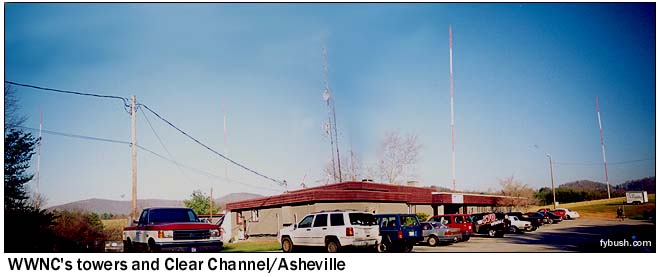
We have just enough time before sunset to scope out Asheville's
AM sites, though the sun is in the wrong position to photograph
most of them, forcing a return sweep early the following morning.
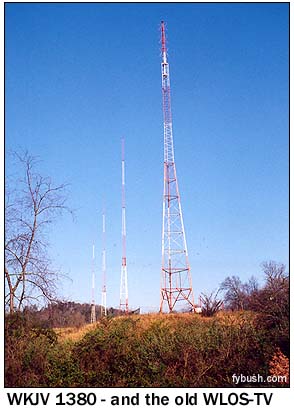 WWNC
(570) is probably the most impressive, with four widely-spaced
towers (so wide we couldn't get them into a single frame, hence
the photomontage above) on a hillside west of downtown Asheville.
This is also the studio site for the rest of Clear Channel's
cluster, including WPEK (880, which picked up the classic country
that WWNC just dropped last year for news-talk) and WKSF ("Kiss
Country" 99.9). WWNC
(570) is probably the most impressive, with four widely-spaced
towers (so wide we couldn't get them into a single frame, hence
the photomontage above) on a hillside west of downtown Asheville.
This is also the studio site for the rest of Clear Channel's
cluster, including WPEK (880, which picked up the classic country
that WWNC just dropped last year for news-talk) and WKSF ("Kiss
Country" 99.9).
That 99.9 facility was WLOS-FM in years gone by, and just
a short drive north from WWNC takes us to the original WLOS(AM),
the facility on 1380 that's now religious WKJV. Today, 1380 runs
25 kilowatts by day from these four towers - and look at that
on the one closest to us: the original batwings of WLOS-TV, back
before it moved to Mount Pisgah and attained regional coverage.
(The WLOS-TV studios were, for many years, on Macon Avenue
north of downtown Asheville, in a rustic complex that's now a
very fancy private resort.)
Not far from the old WLOS-TV studios are the three towers
of WISE (1310), overlooking the French Broad River (go ahead,
make the jokes - we did, too). WISE's studios are here, too,
along with those of WOXL (96.5 Biltmore Forest).
There's a long story surrounding that 96.5 - it was originally
given to Zeb Lee, a veteran Asheville broadcaster who sold his
WSKY (1230) in order to get 96.5 on the air. As WZLS ("Zeb
Lee's Station"), 96.5 operated with a nifty eclectic format
for a few years, beginning in 1994 - but a license challenge
(too complex to get into here; suffice it to say it had to do
with a federal court ruling that struck down much of the FCC's
ability to give preferences to established local operators like
the Lee family) eventually put 96.5 in the hands of an out-of-town
operator, who signed 96.5 on as WZRQ in June 1997.
WZLS, however, didn't sign off - at least not right away -
and for 22 hours, both 96.5 signals fought each other in the
airwaves over Asheville until Lee, then 86, tearfully pulled
the plug. Zeb Lee died not much later, and if you don't believe
that losing his radio station killed him, you've probably never
been bit hard by the radio bug yourself.
Amazingly, WZLS then returned to the air in the fall of 1998,
when a federal appeals court ruled in the Lee family's favor;
a year later, though, the FCC was cleared to put 96.5 up for
auction to the highest bidder - and the Lees couldn't compete
in that arena. In February 2002, WZLS was again ordered off the
air, and 96.5 ended up in the hands of "Liberty Productions,"
who signed the frequency back on with stunting (which we heard
in March 2002, when we passed through Asheville quickly at sunset,
our only previous stop here)
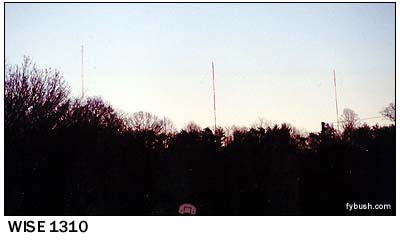 In any event, 96.5
flipped to oldies as WOXL a few weeks after that, and now it's
just another jukebox, more or less. In any event, 96.5
flipped to oldies as WOXL a few weeks after that, and now it's
just another jukebox, more or less.
(You can read the Lee family's whole story at WZLS' still-extant
Web site, www.wzls.com.)
WSKY's single tower is nearby as well, in a hilly neighborhood
just west of downtown Asheville. Downtown, we drive by the studios
of public radio WCQS (88.1), which handles NPR news and classical
music for the region; heading out of town to the east, we also
pass the tower of daytimer WPEK (880).
The next stop on our agenda is supposed to be the highest
point east of the Mississippi, Mount Mitchell, 6,684 feet above
sea level. We turn on to the Blue Ridge Parkway, which leads
to the state road that's paved almost all the way to the summit
- and after half an hour of driving, discover that the road is
still closed because of snow, about 15 miles short of the summit
access! (They could have signed it when we got on, but oh well...and
in any case, a few weeks later Asheville and vicinity made the
national news with a huge mid-April snowstorm.)
Not to be denied, we detour about 70 miles around the mountain,
north to Burnsville, south on NC 80 to the Parkway and then west
again on the Parkway, until we're finally within sight of the
mountain and its transmitters.
 Mount Mitchell -
or rather, Clingman's Peak just adjacent to the summit - has
an important role in early FM history. Mount Mitchell -
or rather, Clingman's Peak just adjacent to the summit - has
an important role in early FM history.
In the summer of 1941, Mount Mitchell Broadcasters built the
road up here and put W41MM on the air, cranking out 50,000 watts
on 44.1 megacycles from 6,885 feet above sea level. (Think that
thing carried? It's reported to have hit seven states in its
regular service area...)
W41MM was licensed to Winston-Salem, 105 miles away, and was
operated by remote telephone line from there.
In later years, W41MM became WMIT, moved to 97.3 and then
to 106.9 - where it ran, for a time, 325 kilowatts from this
high perch! Today, WMIT runs just 35 kw, albeit at 948 meters
above average terrain. It's owned, as it has been for years,
by the Billy Graham Evangelistic Association (they also own WFGW
1010 in nearby Black Mountain, where WMIT's studios are located),
and it still goes for miles and miles and miles. In the photo
at right, WMIT uses the six bays on the left-hand tower; the
taller one in the middle is WNCW, running a directional 17 kw
(protecting adjacent-channel stations in the Triad) from 923
meters above average terrain.
Alas, this telephoto shot is as close as we got; the road
up Clingman's Peak is gated, and it's private property beyond
there. (Maybe next time...)
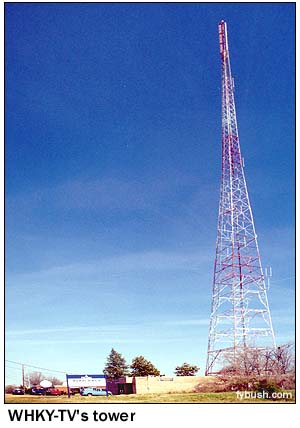 Our next overnight
destination was the Triad, the fast-growing Greensboro/Winston-Salem/High
Point area in central North Carolina, but once we'd wound our
way back down the Parkway to I-40, we first had to pass through
a region known optimistically as "the Unifour." Our next overnight
destination was the Triad, the fast-growing Greensboro/Winston-Salem/High
Point area in central North Carolina, but once we'd wound our
way back down the Parkway to I-40, we first had to pass through
a region known optimistically as "the Unifour."
At least, that's what they call it at WHKY in Hickory, the
locally-owned broadcaster (still owned by the Long family, which
put it on the air in 1939) that operates news-talk AM 1290 and
independent WHKY-TV 14.
The TV station is home to "The Unifour Tonight,"
a funky, very low-budget local news show that we immediately
fell in love with. (You would, too, if you saw the two bookcases
and carved wood "TV 14" sign that make up the set...)
Before getting to Hickory, we passed through Marion, Morganton
and Valdese, each with their local AMs; once in Hickory, we drove
around what seemed to be a very confusing tangle of local streets
until we finally found our way to WHKY-TV (whose tall tower was
easily visible most of the time) and the brick studio building
at its base.
The AM was doing lots of local news; somehow, we managed to
fail to record it - and several other AMs in the region. We'd
love to arrange a trade with any readers who are in, or traveling
to, the Unifour - let us know!
Hickory's two FM allocations, at 95.7 and 102.9, have long
since been swept away to serve Charlotte (which WHKY-TV reaches
as well, thanks to the magic of cable must-carry); 102.9 is the
old WHKY-FM, while 95.7 is paired with WIRC (630), which was
doing a country format from its single tower, east of town near
the four-tower WHKY 1290 array.
WHKY holds a construction permit to boost its daytime power
from 5 kilowatts to 25 kw (which may already be on through an
STA), and an application to go to 50; in the poor conductivity
region of western North Carolina, it needs it!
And from Hickory, it was a quick drive east on I-40 through
Statesville (another town whose FM signals now serve Charlotte
to the south) and into the Triad. Next week: Lexington, our encounter
with the High Point Police, a visit with Jackson Armstrong and
much more!
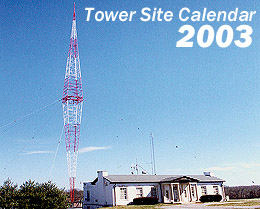 Want to see more neat sticks all year
round? Nashville's WSM (at right) is one of the more than
a dozen Tower Site images featured in the 2003 Tower Site Calendar,
still available from Tower Site of the Week and fybush.com. Want to see more neat sticks all year
round? Nashville's WSM (at right) is one of the more than
a dozen Tower Site images featured in the 2003 Tower Site Calendar,
still available from Tower Site of the Week and fybush.com.
If you liked last year's edition, you'll love this one: higher-quality
images (in addition to WSM, this year's edition includes Providence's
WHJJ; Mount Mansfield, Vermont; Buffalo's WBEN; KOMA in Oklahoma
City; WTIC, Hartford; Brookmans Park, England; WPAT, Paterson;
Four Times Square, New York; WIBC in Indianapolis; WWVA in Wheeling,
W.V.; WGN Chicago and more), more dates in radio history, a convenient
hole for hanging - and we'll even make sure all the dates fall
on the right days!
This year's edition is still available in limited quantities!
And this year, you can order with your Visa, MasterCard,
Discover or American Express by using the handy link below!
Better yet, here's an incentive to make your 2003 NERW/Site
of the Week subscription pledge right now: support NERW/fybush.com
at the $60 level or higher, and you'll get this lovely calendar
for free! How can you go wrong? (Click here
to visit our Support page, where you can make your NERW contribution
with a major credit card...)
You can also order by mail; just send a check for $16
per calendar (NYS residents add 8% sales tax), shipping included,
to Scott Fybush, 92 Bonnie Brae Ave., Rochester
NY 14618.
Thanks for your support!
|